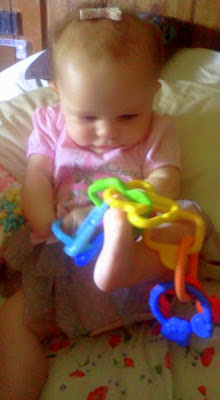"ABS occurs when the fetus becomes entangled in fibrous string-like amniotic bands in the womb, restricting blood flow and affecting the baby’s development.
If a band wraps tightly around a limb, the limb can actually be completely amputated. If the band is across the baby’s face it can cause cleft palate. In a large number of cases the baby is also born with clubfeet. ABS is also the cause of numerous miscarriages, such as when a band becomes wrapped around the umbilical cord. ABS occurs randomly. It’s not genetic, nor is it caused by anything a pregnant Mom did or didn’t do during pregnancy. Just because a person already has one child with ABS, that doesn’t make it any more likely that it’s going to affect a future pregnancy."
From the Shiner's Hospitals for Children website.
"Amniotic band syndrome (ABS) occurs when the fetus is entangled
with strands of amniotic bands that are fibrous and string-like. These
strands in the womb restrict blood flow, affecting the baby’s growth and
development, and can cause deformities to the arms, face, fingers, legs
and toes.
In some cases a fibrous band can be so tightly wrapped around a baby’s limb that it may need to be amputated. Some newborns can have a cleft palate if the bands are across their face, or clubfoot if the bands wrap themselves around their feet.
ABS is caused by damage to a section of the placenta known as the amnion. The placenta is the baby’s source for blood while they are growing in their mother’s womb. ABS is not genetic, nor is it a result of anything the mother did or did not do during pregnancy.
In cases where amniotic band syndrome has affected a limb children may be able to receive a prosthesis. These devices can begin to be used when children are very young, typically when they are neurodevelopmentally ready to begin standing and walking (usually between 12 and 18 months old). Occasionally surgery will be needed to optimize the site where the prosthesis will be attached.
Children whose amniotic band syndrome has affected their face – for example those that have a cleft lip – may require reconstructive surgery to repair the cleft."
In some cases a fibrous band can be so tightly wrapped around a baby’s limb that it may need to be amputated. Some newborns can have a cleft palate if the bands are across their face, or clubfoot if the bands wrap themselves around their feet.
ABS is caused by damage to a section of the placenta known as the amnion. The placenta is the baby’s source for blood while they are growing in their mother’s womb. ABS is not genetic, nor is it a result of anything the mother did or did not do during pregnancy.
Symptoms of Amniotic Band Syndrome
The types of deformities vary depending upon which area of the body the band has restricted blood flow. Symptoms of ABS may include:- An abnormal gap in the newborn’s face, known as a cleft if it goes across the face
- Congenital amputation, a section or an entire limb missing
- Physical defects in the abdomen or chest wall
- A permanent band or indentation mark on the baby’s arm, finger, leg or toe
Diagnosis of Amniotic Band Syndrome
Because ABS occurs in the womb and the defects are visible, your doctor is able to diagnose ABS when your child is born.Treatment of Amniotic Band Syndrome
Shriners Hospitals for Children® offers treatment for ABS that is based upon the severity of the deformities. In some cases, your child’s deformity may not be severe and no treatment may be needed. Children with some physical defects or limb deficiencies may receive physical and occupational therapy to support their growth and development.In cases where amniotic band syndrome has affected a limb children may be able to receive a prosthesis. These devices can begin to be used when children are very young, typically when they are neurodevelopmentally ready to begin standing and walking (usually between 12 and 18 months old). Occasionally surgery will be needed to optimize the site where the prosthesis will be attached.
Children whose amniotic band syndrome has affected their face – for example those that have a cleft lip – may require reconstructive surgery to repair the cleft."

No comments:
Post a Comment